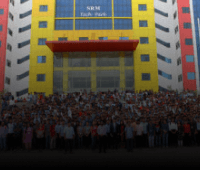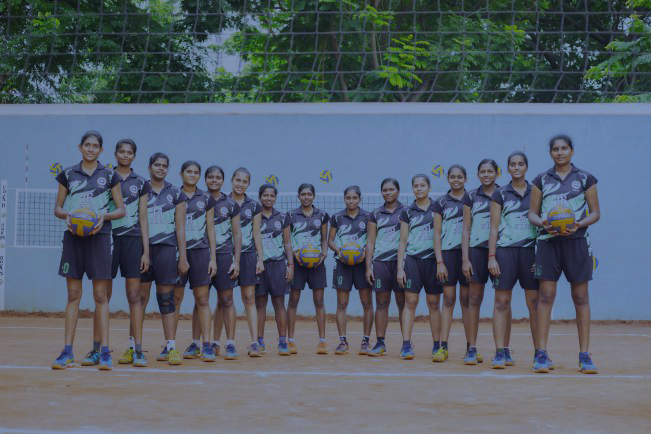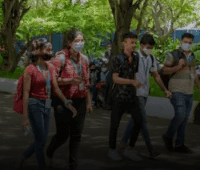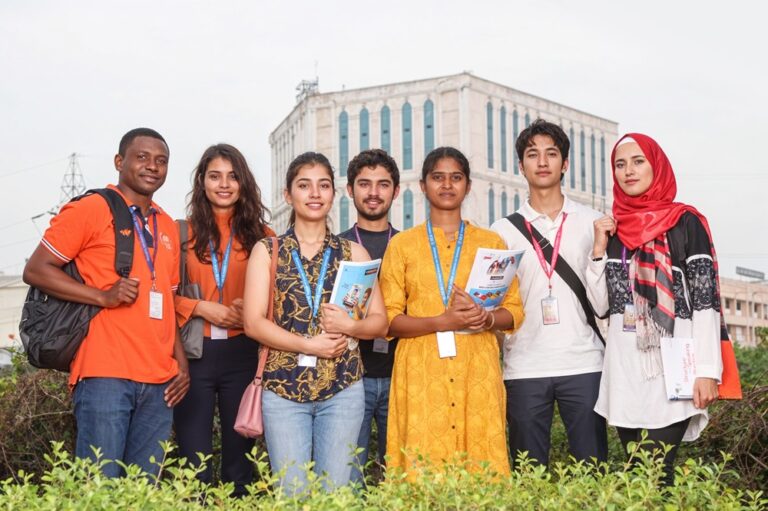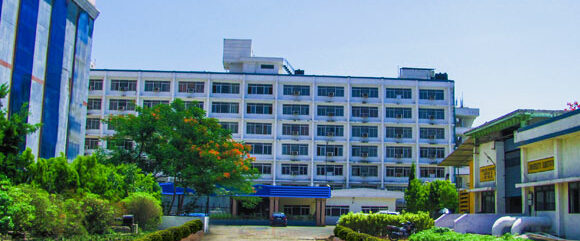B.Tech. Mechanical Engineering
- Home
- Faculty of Engineering & Technology
- Department of Mechanical Engineering
- B.Tech. Mechanical Engineering
Campus
Kattankulathur (KTR)
Sanctioned Intake
240
Annual Fees
INR 2,75,000
Duration
4 Years
B.Tech. Mechanical Engineering
The B.Tech. – Mechanical Engineering program at Kattankulathur campus is accredited by the Engineering Accreditation Commission of ABET, https://www.abet.org.
Explore this Programme
Eligibility for B.Tech. Programme
(a) Nationality and Age
Resident Indian or Non-Resident Indian (NRI), holder of PIO or OCI card issued by Government of India are eligible to apply for SRMJEEE (UG).
Note: NRIs, holders of PIO or OCI card issued by Government of India who has not taken the SRMJEEE (UG) must apply under International student category only.
Should have attained the age of 16 years and 6 months on the 31st July of the calendar year in which the 12th Board examination is to be held (source).
(b) Qualifying Examination:
All B.Tech programmes :
Minimum 60% aggregate in PCM
(i) Passed in Higher secondary examination (10+2 pattern ) or appearing in Higher Secondary examination in the current academic year with Physics and Mathematics as compulsory subjects along with one of the Chemistry/ Biotechnology/ Biology/ Technical Vocational subject/ Computer Science/ Information Technology/ Informatics Practices/ Agriculture/ Engineering Graphics/ Business Studies as major subjects in regular stream from any state board within India, CBSE, ISCE, Matriculation, or NIOS
Note: Students who have completed +2 under NIOS must have completed the 10th standard from regular schooling or vice-versa. (source)
(ii) GCE A-level or International Baccalaureate(IB) diploma or IB certificate with Physics and Mathematics as compulsory subjects along with one of the Chemistry/ Biotechnology/ Biology/ Technical Vocational subject/ Computer Science/ Information Technology/ Informatics Practices/ Agriculture/ Engineering Graphics/ Business Studies as major subjects (equivalent to Advanced Placement level in each subject) in any International schools within India.
(c) SRMJEEE (UG)
Candidates who have attempted Physics, Chemistry, Mathematics, English & Aptitude in SRMJEEE(UG) are eligible for all the B.Tech Degree Programs
(d) Direct Admission
To encourage and support students of exemplary talent, SRM Institute of Science and Technology (formerly known as SRM University) offers direct admission and scholarships to first rank students of all the central and state boards in India, top 10,000 rankers in IIT JEE, top rankers in each district of Tamil Nadu and exemplary sports persons at National and International level.
B.Tech Mechanical Engineering(Part-Time)
The Department of Mechanical Engineering offers B.Tech Mechanical Engineering (Part–Time) for a duration of 3 Years 6 Months.
Eligibility Criteria
Candidates should have completed Diploma in Mechanical Engineering/Automobile Engineering/Mechanical and Rural Engineering/ Mechanical Design and Drafting/Production Engineering/Metallurgy/Mechatronics Engineering/Machine Tool maintenance and Repairs/Tools and Die Making /Tool Engineering/Foundry Technology/Refrigeration and Air Conditioning/Agricultural Engineering/Marine Engineering/Mechanical Engineering (Production)/Mechanical Engineering (Sandwich) /Foundry Technology (Sandwich)/Machine tools maintenance and repairs (sandwich)/Tool and Die making (sandwich)/Production Technology/Tool Design /Mechanical Engineering(tool & Die)/Automobile Technology /Mechanical Engineering(foundry)/Agricultural Technology//Mechanical engineering(Refrigeration and Air-conditioning)/Electronics(Robotics)/Agricultural engineering and Farm Equipment Technology/Production Engineering(Sandwich)/Mechatronics Engineering (Sandwich)/Electronics –Robotics (sandwich) with two years of work experience.
No objection Certificate (NOC) from the current Employer is needed.
Program Educational Objectives
Practice mechanical engineering in different disciplines towards system design, realization, and manufacturing
Enhance professional practice to meet the global standards with ethical and social responsibility
Solve industrial, social, and environmental problems with appropriate techniques and tools
Work in large cross-functional teams and pursue life-long learning
Mapping between NBA program outcomes and EAC ABET student outcomes 2022-23
|
NBA- Program Outcomes (PO) |
Student Outcomes (SO) EAC, ABET |
|
PO1 Engineering Knowledge: Apply the knowledge of mathematics, science, engineering fundamentals, and an engineering specialization to the solution of complex engineering problems |
SO1 An ability to identify, formulate, and solve complex engineering problems by applying principles of engineering, science, and mathematics |
|
PO2 Problem Analysis: Identify, formulate, review research literature, and analyze complex engineering problems reaching substantiated conclusions using first principles of mathematics, natural sciences and engineering sciences |
|
|
PO3 Design/Development of Solutions: Design solutions for complex engineering problems and design system components or processes that meet the specified needs with appropriate consideration for the public health and safety, and the cultural, societal, and environmental considerations
|
SO2 An ability to apply engineering design to produce solutions that meet specified needs with consideration of public health, safety, and welfare, as well as global, cultural, social, environmental, and economic factors |
|
PO4 Conduct Investigations of Complex Problems: Use research-based knowledge and research methods including design of experiments, analysis and interpretation of data, and synthesis of the information to provide valid conclusions for complex problems: that cannot be solved by straightforward application of knowledge, theories and techniques applicable to the engineering discipline as against problems given at the end of chapters in a typical text book that can be solved using simple engineering theories and techniques;
|
SO6 An ability to develop and conduct appropriate experimentation, analyze and interpret data, and use engineering judgment to draw conclusions
|
|
PO5 Modern Tool Usage: Create, select, and apply appropriate techniques, resources, and modern engineering and IT tools including prediction and modelling to complex engineering activities with an understanding of the limitations |
|
|
PO6 The Engineer and Society: Apply reasoning informed by the contextual knowledge to assess societal, health, safety, legal and cultural issues and the consequent responsibilities relevant to the professional engineering practice |
SO4 An ability to recognize ethical and professional responsibilities in engineering situations and make informed judgments, which must consider the impact of engineering solutions in global, economic, environmental, and societal contexts |
|
PO7 Environment and Sustainability: Understand the impact of the professional engineering solutions in societal and environmental contexts, and demonstrate the knowledge of, and need for sustainable development |
|
|
PO8 Ethics: Apply ethical principles and commit to professional ethics and responsibilities and norms of the engineering practice |
|
|
PO9 Individual and Team Work: Function effectively as an individual, and as a member or leader in diverse teams, and in multidisciplinary settings |
SO5 An ability to function effectively on a team whose members together provide leadership, create a collaborative and inclusive environment, establish goals, plan tasks, and meet objectives |
|
PO10 Communication: Communicate effectively on complex engineering activities with the engineering community and with society at large, such as, being able to comprehend and write effective reports and design documentation, make effective presentations, and give and receive clear instructions |
SO3 An ability to communicate effectively with a range of audiences
|
|
PO11 Project Management and Finance: Demonstrate knowledge and understanding of the engineering and management principles and apply these to one’s own work, as a member and leader in a team, to manage projects and in multidisciplinary environments |
SO5 An ability to function effectively on a team whose members together provide leadership, create a collaborative and inclusive environment, establish goals, plan tasks, and meet objectives |
|
PO12 Life-long Learning: Recognize the need for, and have the preparation and ability to engage in independent and lifelong learning in the broadest context of technological change |
SO7 An ability to acquire and apply new knowledge as needed, using appropriate learning strategies |
Details of enrolled strength and passed out
| Batch | Actual enrolment | Graduated |
| 2017-2021 | 424 | 411 |
| 2016-2020 | 877 | 827 |
| 2015-2019 | 880 | 689 |
| 2014-2018 | 701 | 588 |
| 2013-2017 | 697 | 583 |
how to apply
Step 1 - register
Sign up or Register for CET with basic details (Name, Email ID, Mobile No., State, Gender and Password). Your Email ID will act as your Username for the portal while the password will be set by you upon registration.
On successful registration, you will receive the confirmation message on your registered contact number and Email. Use the Username and Password to Login to your CET Account.
Step 2 - register
Nemo enim ipsam voluptatem quia voluptas sit aspernatur aut odit aut fugit, sed quia consequuntur magni dolores eos qui rationeNemo enim ipsam voluptatem quia voluptas sit aspernatur
On successful registration, you will receive the confirmation message on your registered contact number and Email. Use the Username and Password to Login to your CET Account.
Step 3 - register
Sign up or Register for CET with basic details (Name, Email ID, Mobile No., State, Gender and Password). Your Email ID will act as your Username for the portal while the password will be set by you upon registration.
On successful registration, you will receive the confirmation message on your registered contact number and Email. Use the Username and Password to Login to your CET Account.
Step 1 – register
Sign up or Register for CET with basic details (Name, Email ID, Mobile No., State, Gender and Password). Your Email ID will act as your Username for the portal while the password will be set by you upon registration.
On successful registration, you will receive the confirmation message on your registered contact number and Email. Use the Username and Password to Login to your CET Account.
Step 2 – register
Nemo enim ipsam voluptatem quia voluptas sit aspernatur aut odit aut fugit, sed quia consequuntur magni dolores eos qui rationeNemo enim ipsam voluptatem quia voluptas sit aspernatur
On successful registration, you will receive the confirmation message on your registered contact number and Email. Use the Username and Password to Login to your CET Account.
Step 3 – register
Sign up or Register for CET with basic details (Name, Email ID, Mobile No., State, Gender and Password). Your Email ID will act as your Username for the portal while the password will be set by you upon registration.
On successful registration, you will receive the confirmation message on your registered contact number and Email. Use the Username and Password to Login to your CET Account.


